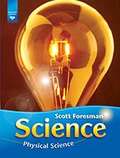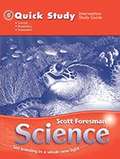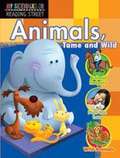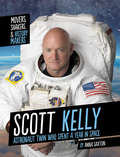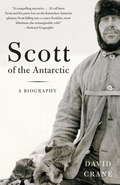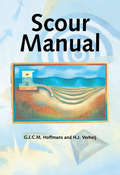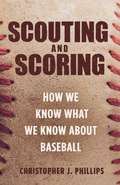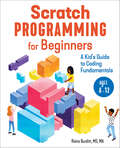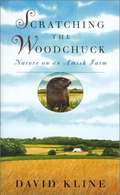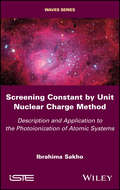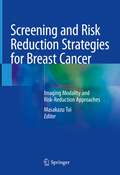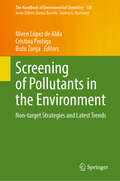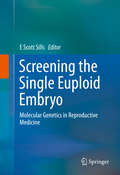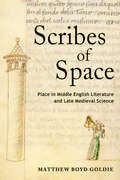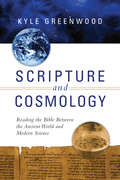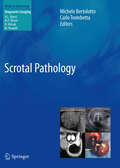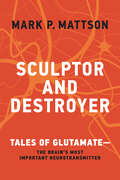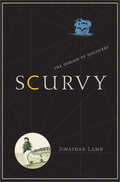- Table View
- List View
Scott Foresman Science: Life Science (Grade 6, The Diamond Edition)
by Scott ForesmanA book dealing in Classification of living things, cells, Reproduction, Body Systems, Plants, Biomes, Ecosystems and much more.
Scott Foresman Science: Physical Science
by Scott ForesmanScott Foresman Science: Physical Science contains unit lessons on Life Science, Physical Science, Earth Science, and Human Body.
Scott Foresman Science: Physical Science (Grade #4)
by Jim Cummins Timothy Cooney James Flood Barbara Kay Foots M. Jenice Goldston Shirley Gholston Key Diane Lapp Sheryl A. Mercier Karen L. Ostlund Nancy Romance William Tate Kathryn C. Thornton Leon Ukens Steve WeinbergThis book designed to develop student's knowledge about Life science, Earth science, Physical science, space and technology etc.
Scott Foresman Science: Physical Science (Grade #5)
by Jim Cummins Timothy Cooney James Flood M. Jenice Goldston Diane Lapp Sheryl A. Mercier Karen L. Ostlund Nancy Romance William Tate Kathryn C. Thornton Leon Ukens Steve Weinberg Barbara Foots Shirley Goldston KeyThis book designed to develop student's knowledge about life science, earth science, physical science, space and technology etc.
Scott Foresman Science: Physical Science (Grade 1,The Diamond Edition)
by Scott ForesmanScientists classify living things in the ocean. You classify when you sort or group things by their properties.
Scott Foresman Science: Physical Science (Grade 3, The Diamond Edition)
by Jim Cummins Timothy Cooney James Flood Barbara Kay Foots M. Jenice Goldston Shirley Gholston Key Diane Lapp Sheryl A. Mercier Karen L. Ostlund Nancy Romance William Tate Kathryn C. Thornton Leon Ukens Steve WeinbergThis book designed to develop student's knowledge about science.
Scott Foresman Science: Quick Study, 5th Grade
by Scott ForesmanA quick study into life science, earth science, physical science and space & technology
Scott Foresman Science: See Learning in a Whole New Light (Grade #2)
by James Flood M. Jenice Goldston Shirley Gholston Key Diane Lapp Nancy Romance William Tate Timothy Gooney Barbara Foots Sheryl Alicia Mercier Karen OstlundThis book designed to develop student's knowledge about life science, earth science, physical science, space and technology etc.
Scott Foresman Sidewalks, Animals Tame and Wild [Grade 1, Level A1]
by Sharon Vaughn Connie Juel Deborah Simmons Jeanne R. ParatoreNIMAC-sourced textbook
Scott Foresman Social Studies: All Together (Texas Edition)
by Candy Dawson Boyd Geneva Gay Rita Geiger James B. KrachtGeography is the study of Earth. This study sometimes looks at the earth in five different ways. These ways are called the five themes of geography. Each theme is another way of thinking about a place.
Scott Kelly: Astronaut Twin Who Spent a Year in Space (Movers, Shakers, and History Makers)
by Anna SaxtonScott Kelly, an American astronaut, went to space in the 1990s and 2000s. In 2015, he spent nearly a year in space. While there, his body was compared to his twin's on the ground. The data helped us learn about the impacts of space on the human body. Learn more about Kelly's life as an astronaut!
Scott of the Antarctic: A Biography
by David CraneHistorian David Crane, with full access to the explorer's papers, diaries, and expedition records, gives us an illuminating portrait of Robert Falcon Scott that is more nuanced and balanced than any we have had before. In reassessing Scott's life, Crane is able to provide a fresh perspective on not only the Discovery expedition of 1901-4 and the Terra Nova expedition of 1910-13, but his remarkable scientific achievements and the challenges of his tumultuous private life. Neither foolhardy dilettante, nor the last romantic champion of his age, Scott is presented as a man of indomitable courage and questionable judgment. The result is an absolutely compelling portrait of a complicated hero.
Scour Manual: Current-related Erosion
by G.J.C.M. HoffmansThe mechanisms and behaviour of the scour process is a challenging subject, and one which is expertly dealt with in this informative, illustrated volume. Specifically, this book addresses issues relating to computing and controlling the scour process near hydraulic structures, and pays special attention to the time-dependent character of the scour processes and the predictability of scour relations. Providing information on the latest developments in scouring, this text is intended for practising hydraulic engineers.
Scouting and Scoring: How We Know What We Know about Baseball
by Christopher PhillipsAn in-depth look at the intersection of judgment and statistics in baseballScouting and scoring are considered fundamentally different ways of ascertaining value in baseball. Scouting seems to rely on experience and intuition, scoring on performance metrics and statistics. In Scouting and Scoring, Christopher Phillips rejects these simplistic divisions. He shows how both scouts and scorers rely on numbers, bureaucracy, trust, and human labor in order to make sound judgments about the value of baseball players.Tracing baseball’s story from the nineteenth century to today, Phillips explains that the sport was one of the earliest and most consequential fields for the introduction of numerical analysis. New technologies and methods of data collection were supposed to enable teams to quantify the drafting and managing of players—replacing scouting with scoring. But that’s not how things turned out. Over the decades, scouting and scoring started looking increasingly similar. Scouts expressed their judgments in highly formulaic ways, using numerical grades and scientific instruments to evaluate players. Scorers drew on moral judgments, depended on human labor to maintain and correct data, and designed bureaucratic systems to make statistics appear reliable. From the invention of official scorers and Statcast to the creation of the Major League Scouting Bureau, the history of baseball reveals the inextricable connections between human expertise and data science.A unique consideration of the role of quantitative measurement and human judgment, Scouting and Scoring provides an entirely fresh understanding of baseball by showing what the sport reveals about reliable knowledge in the modern world.
Scratch Programming for Beginners: A Kid's Guide to Coding Fundamentals
by Raina BurdittThink like a coder—the fun guide to Scratch programming for ages 8-12Scratch is a visual computer language designed especially for kids, and Scratch Programming for Beginners is the perfect book to introduce kids to coding! It explains the fundamental concepts of Scratch in a kid-friendly way, and comes jam-packed with fun, creative activities.This book starts with the scratch programming basics, teaching kids what coding is, and all about the different tools they can use to build their own programs and games. Each chapter teaches a different aspect of coding, with exercises that get more challenging as they go, so kids can test their abilities and unleash their imagination. They'll even build their own game where they'll fight off a fire-breathing dragon!Inside Scratch Programming for Beginners, you'll find:No coding experience needed—This book is designed for coding beginners, with kid-friendly explanations, step-by-step instructions, and lots of pictures.Build a coding toolbox—Kids will build their own toolbox of skills, learning how to install and use Scratch, how to troubleshoot any pesky coding bugs with the Bug-Hunting Guide, and practice their Scratch programming lingo with a glossary of computer terms.Why Scratch?—Scratch uses blocks of code that fit together like puzzle pieces, so kids can watch how their code affects the program as they're building it. The fundamentals they'll learn in this book apply to other coding languages, too!Give kids the tools to build anything they can dream up, with a starter guide to scratch programming.
Scratching the Woodchuck: Nature on an Amish Farm
by David Kline"The title of Scratching the Woodchuck comes from an encounter Kline had one summery day near his farm. As he was out walking, he came upon a woodchuck sleeping at the base of an oak tree. In a gesture that speaks eloquently of Kline's relationship with the natural world, he reached over and scratched the animal with his walking stick. Rather than being startled, the sleeping creature arched its back with pleasure at the attention." "Kline's writings ring with reverence, knowledge, and a joyful spirit, and to accompany him as he explores the fields, creeks, and woods around his farm is to share his connection with the earth. In both his writing and his work, he embodies a love of nature and a unity with our fellow creatures while offering a testimony to sustainable farming and living as a true steward of the land."--BOOK JACKET.Title Summary field provided by Blackwell North America, Inc. All Rights Reserved
Screening Constant by Unit Nuclear Charge Method: Description and Application to the Photoionization of Atomic Systems
by Ibrahima SakhoThe reader will find in this collection a clear exposition of the method of the Screen Constant by Nuclear Charge Unit which can be applied in a simple and immediate way to many fields of Physics in relation to atomic spectroscopy.
Screening and Risk Reduction Strategies for Breast Cancer: Imaging Modality and Risk-Reduction Approaches
by Masakazu ToiThis book provides readers with the most up-to-date practical information on breast cancer screening. Since breast cancers are highly heterogeneous, time to clinical onset from the initial carcinogenesis differs diversely between cancers. Pathological germline variants and driver mutations cause a high lifetime risk of breast cancer. The lifetime risks are various according to what genes are pathologically dysfunctional. Integrated omics and imaging technologies have established varying tumour characteristics. Thus, this book suggests that a more individualised scheme is required to improve breast cancer screening. A key aim is to demonstrate how multiple diagnostic imaging modalities such as mammography, ultrasonography, MRI, PET and dbPET improve breast cancer screening accuracy. Mammography screening alone may have a limited impact on breast cancer risk prediction. These issues are crucial to discuss. Clinical experts recommend that new modalities be incorporated for women with dense breasts, like ultrasonography, dynamic mammography, MRI and maybe breast-dedicated PET. Topics on these modalities are going to be summarized in this book. An in-depth review of these modalities is summarised in this book. In addition, new diagnostic modalities, including risk assessment tools, multi-cancer early detection tests using liquid biopsy, the role of protein biomarkers in breast cancer risk screening, challenges, and hopes for future advances, are also covered in this book.
Screening of Pollutants in the Environment: Non-target Strategies and Latest Trends (The Handbook of Environmental Chemistry #138)
by Miren López de Alda Cristina Postigo Božo ŽonjaThis book reviews the latest advances in mass spectrometry for detecting environmental pollutants. With high-resolution mass spectrometry instruments becoming more accessible in research labs, scientists can now expand their analytical capabilities, establishing non-target strategies to identify priority pollutants and uncover new potentially hazardous compounds in various environmental compartments.In this book, readers will find a range of critical topics, including the use of ion mobility as a third dimension for compound confirmation in environmental samples, and the integration of high-resolution mass spectrometry analysis with market data to prioritize environmental contaminants. The book also explores effect-directed methods combined with non-target screening for identifying toxic transformation products, and the combination of passive sampling with non-target analysis for comprehensive environmental assessments. Additionally, it covers screening strategies for disinfection byproducts in drinking water and the human chemical exposome, providing insights into the quantitation of non-target data and the discovery of transformation byproducts of emerging contaminants.Given its breadth, this book is an essential resource for scientists addressing environmental pollution, students and academics in environmental analytical chemistry, and researchers focused on water, soil, and air studies. Environmental managers and engineers designing novel pollution remediation systems will find innovative strategies to advance their work. By focusing on priority pollutants and novel screening strategies, this book equips readers with the knowledge to tackle pressing environmental challenges.
Screening the Single Euploid Embryo
by E Scott SillsIntended for readers with a background in fertility medicine as well as those less familiar with IVF, this comprehensive work presents an update on preimplantation genetic testing to enable single embryo transfer (SET). An international cast of contributors explains the treatment sequence--from ovulation induction to luteal support--aiming to transfer only one euploid embryo. Applications of molecular techniques for gamete and embryo assessment are fully detailed, with a focus on the strengths and limitations of each. In addition, expert commentary is shared across a range of regulatory challenges associated with embryo screening and cryopreservation. As access to advanced reproductive technology increases against a sharper background of healthcare reform, clinicians, economists, bioethicists and legislators alike will find this new volume relevant and highly accessible.
Scribes of Space: Place in Middle English Literature and Late Medieval Science
by Matthew Boyd GoldieScribes of Space posits that the conception of space—the everyday physical areas we perceive and through which we move—underwent critical transformations between the thirteenth and fifteenth centuries. Matthew Boyd Goldie examines how natural philosophers, theologians, poets, and other thinkers in late medieval Britain altered the ideas about geographical space they inherited from the ancient world. In tracing the causes and nature of these developments, and how geographical space was consequently understood, Goldie focuses on the intersection of medieval science, theology, and literature, deftly bringing a wide range of writings—scientific works by Nicole Oresme, Jean Buridan, the Merton School of Oxford Calculators, and Thomas Bradwardine; spiritual, poetic, and travel writings by John Lydgate, Robert Henryson, Margery Kempe, the Mandeville author, and Geoffrey Chaucer—into conversation. This pairing of physics and literature uncovers how the understanding of spatial boundaries, locality, elevation, motion, and proximity shifted across time, signaling the emergence of a new spatial imagination during this era.
Scripture and Cosmology: Reading the Bible Between the Ancient World and Modern Science
by Kyle GreenwoodChristians often claim to hold a biblical worldview. But what about a biblical cosmos view? From the beginning of Genesis we encounter a vaulted dome above the earth, a "firmament," like the ceiling of a planetarium. Elsewhere we read of the earth sitting on pillars. What does the dome of heaven have to do with deep space? Even when the biblical language is clearly poetic, it seems to be funded by a very different understanding of how the cosmos is put together. As Kyle Greenwood shows, the language of the Bible is also that of the ancient Near Eastern palace, temple and hearth. There was no other way of thinking or speaking of earth and sky or the sun, moon and stars. But when the psalmist looked at the heavens, the delicate fingerwork of God, it evoked wonder. Even today it is astronomy and cosmology that invoke our awe and point toward the depths of divine mystery. Greenwood helps us see how the best Christian thinkers have viewed the cosmos in light of Scripture—and grappled with new understandings as science has advanced from Aristotle to Copernicus to Galileo and the galaxies of deep space. It's a compelling story that both illuminates the text of Scripture and helps us find our own place in the tradition of faithful Christian thinking and interpretation.
Scrotal Pathology
by Carlo Trombetta Michele BertolottoScrotal Pathology is a comprehensive practical guide to the management of patients who present with scrotal disorders. Introductory chapters consider imaging instrumentation, clinical evaluation, and clinical and imaging anatomy. The full range of disorders is then discussed in individual chapters organized according to clinical presentation. All clinical and imaging aspects are covered in depth, with full description of symptoms and explanation of the value of different clinical tests and imaging modalities. In addition, underlying histopathological features are presented and correlated with imaging features in order to clarify their pathological basis. For each disorder, therapeutic strategies are discussed and appraised. Adults and children are considered separately whenever necessary, bearing in mind that they often present essentially different scrotal pathology. The many images are all of high quality and were obtained using high-end equipment.
Sculptor and Destroyer: Tales of Glutamatethe Brain's Most Important Neurotransmitter
by Mark P. MattsonThe fascinating story of glutamate, the neurotransmitter that controls the structure and function of the brain in health and neurological disorders.Sculptor and Destroyer tells the story of a simple, little-known molecule that became a master architect and commander of the human brain: glutamate. Upward of 90 percent of the neurons in the human brain deploy glutamate as their neurotransmitter. Other neurotransmitters can only exert their effects on brain function by subtly modifying the ongoing activity of glutamatergic neurons, but during brain development glutamate controls the growth of dendrites and the formation of synapses. In this eye-opening book, Mark Mattson explains how the neurotransmitter glutamate controls the structure and function of neuronal networks in the brain, thereby mediating the brain&’s capabilities, including learning and memory, creativity, and imagination.Mattson also delves deeply into the dark side of glutamate, which he calls the &“destroyer&” side. He shows how relatively subtle aberrancies in the activity of neurons that deploy glutamate may result in behavioral disorders ranging from autism and schizophrenia to chronic anxiety and depression. More dramatically, he describes how glutamate can excite neurons to death, a process that occurs in epilepsy and stroke and, perhaps even more insidiously, in Alzheimer&’s disease, Parkinson&’s disease, ALS, and Huntington&’s disease. Sculptor and Destroyer concludes with a perspective on how knowledge of glutamate&’s roles in neuroplasticity might be applied to the optimization of brain health throughout our lives.Written in engaging, approachable prose, Sculptor and Destroyer will be of interest to anyone in the fields of neuroscience, neurology, psychiatry, and psychology, as well as to anyone with a curiosity about the human brain.
Scurvy: The Disease of Discovery
by Jonathan LambScurvy, a disease often associated with long stretches of maritime travel, generated sensations exceeding the standard of what was normal. Eyes dazzled, skin was morbidly sensitive, emotions veered between disgust and delight. In this book, Jonathan Lamb presents an intellectual history of scurvy unlike any other, probing the speechless encounter with powerful sensations to tell the story of the disease that its victims couldn't because they found their illness too terrible and, in some cases, too exciting.Drawing on historical accounts from scientists and voyagers as well as major literary works, Lamb traces the cultural impact of scurvy during the eighteenth-century age of geographical and scientific discovery. He explains the medical knowledge surrounding scurvy and the debates about its cause, prevention, and attempted cures. He vividly describes the phenomenon and experience of "scorbutic nostalgia," in which victims imagined mirages of food, water, or home, and then wept when such pleasures proved impossible to consume or reach. Lamb argues that a culture of scurvy arose in the colony of Australia, which was prey to the disease in its early years, and identifies a literature of scurvy in the works of such figures as Herman Melville, Samuel Taylor Coleridge, Francis Bacon, and Jonathan Swift.Masterful and illuminating, Scurvy shows how the journeys of discovery in the eighteenth century not only ventured outward to the ends of the earth, but were also an inward voyage into the realms of sensation and passion.

